|
|
|
Sort Order |
|
|
|
Items / Page
|
|
|
|
|
|
|
| Srl | Item |
| 1 |
ID:
168837
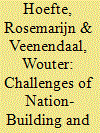

|
|
|
|
|
| Summary/Abstract |
This analysis of nation-building and nation branding in post-colonial, multi-ethnic Suriname builds on the notion that such policies are promising but also difficult to achieve in culturally divided societies. We zoom in on three episodes of nation-building and nation branding in the country and explain why and in what respects they succeeded or failed. We posit that in Suriname’s case, nation-building and nation branding are intertwined, because the latter cannot be seen in isolation from nation-building. In the Conclusion, we discuss the effects of colonial legacies in multi-ethnic societies on nation-building and nation branding.
|
|
|
|
|
|
|
|
|
|
|
|
|
|
|
|
| 2 |
ID:
137238
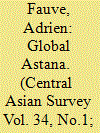

|
|
|
|
|
| Summary/Abstract |
This paper examines how, in post-Soviet Kazakhstan, both channels of elite and banal nationalism (such as sports and higher education) serve as instruments to promote the country. Through these channels, Kazakhstan is portrayed as an open, dynamic and successful country, an image which is in serious disjuncture with the authoritarian nature of the regime. Taking advantage of massive oil revenues, the government organized a significant OSCE general conference in 2010, while chairing the institution. In addition, it created the Astana professional cycling team, which rapidly became a world leader in the sport. Last but not least, Nazarbayev University, attracting prominent Western scholars, is now designed to make the country compete in the international arena of academic rankings. Domestic and international performances are thus treated as instruments to promote the legitimacy of the state at national and global levels. But this would not be possible without the help of individual actors who actively participate in this process. A close investigation shows that their social capital is based on global connections in various spheres (sports, finance and academia). This paper draws on evidence gathered through qualitative methods of enquiry (participant observation and semi-structured interviews). Finally, Astana is treated as a Latourian actor-network that has its own life and agency, thanks to the global association of various human actors and material objects.
|
|
|
|
|
|
|
|
|
|
|
|
|
|
|
|
| 3 |
ID:
148549
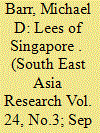

|
|
|
|
|
| Summary/Abstract |
It is no secret that a dynasty has emerged as the ruling force in Singapore. The Lee family (of former Prime Minister Lee Kuan Yew and current Prime Minister Lee Hsien Loong) is referred to as ‘the first family’ as a matter of routine in private conversation, though not usually in public. Power has already passed from father to son and now there is a generation of high-flying grandsons in the wings. This article traces the establishment and consolidation of the Lee dynasty from the point in the early 1980s when Lee Kuan Yew emerged as the centre of all the significant power networks in Singapore, through to the consolidation of power in the hands of his son, Lee Hsien Loong, in 2011. In the process of doing this, it argues that despite official rhetoric that says that the country runs on the talent of the best and most talented men and women in the country, and the closely related myth that professionalism provides the basis of governance, the reality is that of rule by a family-based clique of confidantes and relatives. There is a strong element of reality to both myths, but both elements are ultimately subordinated to and in the service of the forces of consanguineous and personal networks.
|
|
|
|
|
|
|
|
|
|
|
|
|
|
|
|
| 4 |
ID:
170928
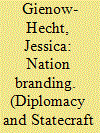

|
|
|
|
|
| Summary/Abstract |
This analysis suggests nation branding” as a useful category for the study of international relations and international history. In the past 15 years, entrepreneurs have invented nation branding as something new and modern, and governments the world over have signed up for cost-intensive campaigns to brand their countries’ images abroad. However, practices of nation branding have been around much longer. Indeed, the history of nation branding avant la lettre needs writing. That history provides a major encasement for the multitude of individual studies dedicated to soft power, public diplomacy, and cultural relations across time and space. This analysis looks first the at current experts and discourses on nation branding. Second, it sketches nation branding’s emergence from the end of the early modern period to the present. Third, it suggests a number of historical examples to inspire future research.
|
|
|
|
|
|
|
|
|
|
|
|
|
|
|
|
| 5 |
ID:
155448
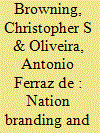

|
|
|
|
|
| Summary/Abstract |
To date, (critical) geopolitics has had little to say about contemporary competitive identity practices of nation branding in global politics, while existing analyses of nation branding in other disciplines have tended to overlook its geopolitical dimensions. This expanded Introduction (and the special section as a whole) therefore seeks to explore some of the implications of nation branding for geopolitics, while simultaneously utilising the insights of critical geopolitics to shed light on nation branding practices. The Introduction makes the case for a broad conception of nation branding that challenges claims it is immutably linked to capitalist logics in an era of globalisation. It subsequently explores claims that nation branding is simply an updated form of nation building and that it is also an inherently benign and peace promoting activity. The Introduction ends by highlighting how, despite claims that the contemporary prevalence of nation branding practices is indicative of a categorical shift from a geopolitical to a geoeconomic world, nation branding practices frequently remain deeply infused with rather traditional geopolitical scripts.
|
|
|
|
|
|
|
|
|
|
|
|
|
|
|
|
| 6 |
ID:
114669
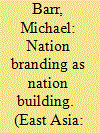

|
|
|
|
|
| Publication |
2012.
|
| Summary/Abstract |
This paper illustrates the links between China's nation building exercises
and its efforts to promote the country as a 'brand'. By using the examples of the
Shanghai Expo, China's national image films and the revival of Confucius, I show
how Chinese soft power is both inward and outward looking. Understanding this
dual role of soft power is important in comprehending the underlying motivations
behind China's attempts to create and manage its identity as orderly, prosperous and
legitimate.
|
|
|
|
|
|
|
|
|
|
|
|
|
|
|
|
| 7 |
ID:
155458
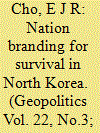

|
|
|
|
|
| Summary/Abstract |
The article problematises a popular view in nation branding literature that equates nation branding with states’ attendant advertising campaigns. Instead, this article adopts a broader perspective that nation branding can also operate as a policy aimed at enhancing the sense of ontological security among states and as a practice to strengthen the position of the ruling regime by targeting particular audiences within a broader ‘strategic narrative’. From this perspective, this article aims to shed new light on non-liberal capitalist countries’ – specifically North Korea’s – attempts at nation branding policies in terms of various nation branding strategies. In so doing, Clifford Geertz’s anthropological concept of ‘theatre state’ is introduced as an important metaphor to broaden the existing understanding of nation branding by highlighting the unique characteristics of North Korea’s policies of nation branding and nation building. It is argued that great national spectacles such as the Arirang Festival and military demonstrations provide North Korea with a useful platform for participating in the identity competition among other nation states, as well as in the fierce recognition game against the rest of the Korean national community. Obviously, these strategic performances have contributed to communicating with the outside world, deliberately seeking more respect from others, but have simultaneously operated as nation building processes. Therefore, this work concludes that such staged events are sophisticatedly designed to enhance North Korea’s complex interest of nation branding, and, more importantly, argues that techniques and practices of nation branding are neither historically new nor confined to Western liberal capitalist regimes.
|
|
|
|
|
|
|
|
|
|
|
|
|
|
|
|
| 8 |
ID:
090574
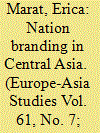

|
|
|
|
|
| Publication |
2009.
|
| Summary/Abstract |
This essay examines the national images that Central Asian states are trying to present to international audiences. Since 1991 all Central Asian states have created national ideologies, but only three-Kazakhstan, Kyrgyzstan and Uzbekistan-have programmes in place to capture the attention of foreign businessmen, politicians and tourists. Following the pattern of crafting national ideologies for domestic audiences in all three states, the ruling elites have led the effort to create a unique national 'brand' identity for their country.
|
|
|
|
|
|
|
|
|
|
|
|
|
|
|
|
| 9 |
ID:
187508
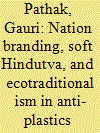

|
|
|
|
|
| Summary/Abstract |
A recent dimension of India’s nation-branding project, by which it aims to attract investment, trade, human resources, and tourists to the country, has been a focus on a ‘green’ India as a global leader in sustainable development. As part of this strategy, messages aimed at a national and external audience are aligned, and a line is drawn between the country’s putative ecologically sensitive past and a green future. Such messages highlight selective, sanitised, and idealised Hindu texts and praxis related to the environment as evidence of India’s innate ecological sensitivity. The environment thus becomes a domain for the permeation of a seemingly apolitical strand of Hindutva rhetoric, which emphasises the civilisational wisdom of Indian (coded as Hindu) thought and presents it for consumption by national and global audiences. In this article, using anti-plastics discourses as a lens, I investigate the cultural politics of this emerging stream of Hindutva-linked ‘ecotraditionalism’.
|
|
|
|
|
|
|
|
|
|
|
|
|
|
|
|
| 10 |
ID:
107322
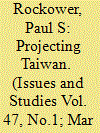

|
|
|
|
|
| Publication |
2011.
|
| Summary/Abstract |
Because of its diplomatic isolation, Taiwan has used, and continues to rise, public diplomacy as a vital medium for presenting its values and utility in the international community while bypassing issues of recognition. This article examines Taiwan's public diplomacy and soft power projection. It analyzes Taiwan's public diplomacy outreach and evaluates its public diplomacy strategies and tactics by focusing on Taiwan's ability to present its utility relevance, and values to the international community. It assesses Taiwan's public diplomacy institutions and tools, and the instruments employed to implement public diplomacy outreach. Further, more, it examines Taiwanese soft power and the elements that enhance its "power of influence." The author categorizes Taiwan as a "middle power" and compares its public diplomacy efforts to those of similar middle power slates, especially in relation to the public diplomacy strategy of niche diplomacy.
|
|
|
|
|
|
|
|
|
|
|
|
|
|
|
|
| 11 |
ID:
190925
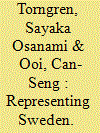

|
|
|
|
|
| Summary/Abstract |
In 2011, the Swedish national tourism organisation, Visit Sweden, together with the Swedish Institute, launched a campaign – Curators of Sweden (CoS) – on Twitter, which ended in 2018. Each week a ‘Swedish’ person was chosen as a curator to tweet whatever they liked through the @Sweden account. All the curators were chosen because they represented ‘values, skills, and ideas’ which, according to the campaign, ‘all combined, makes up Sweden’. In this article, we try to understand the contradiction of CoS offering a cacophony of ‘diverse’ voices from Swedes but, at the same time, speaking with the ‘same’ voice. Through dialogism, we locate the different voices, agendas and diverse contexts in reality, and examine how the values, skills and ideas were managed and engineered through the CoS, in a bid to imagine Sweden and Swedish identity.
|
|
|
|
|
|
|
|
|
|
|
|
|
|
|
|
| 12 |
ID:
191699


|
|
|
|
|
| Summary/Abstract |
This essay investigates competing visibilities within a cultural practice that India has promoted as a privileged image of national identity: yoga. These competing perceptions, in which yoga can be seen as at once iconically and yet not uniquely Indian, pose a challenge for the Indian state in its management of yoga’s symbolic value. Analysing rhetoric from India’s nation-branding pursuits in the context of Western popular culture, I argue that the state manipulates visual regimes of yoga in ways that turn this spectre of Indian invisibility into a testament to Indian ubiquity. Invisibility as a problem is thus transformed into invisibility as a privilege, revealing how the potential fluidity across two different regimes of identity and power can render state fantasies more resilient.
|
|
|
|
|
|
|
|
|
|
|
|
|
|
|
|
| 13 |
ID:
146005
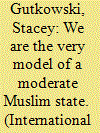

|
|
|
|
|
| Summary/Abstract |
Despite its significance to one of the most problematic discursive binaries of the ‘War on Terror’, moderation has been a largely taken for granted theoretical and empirical category in the discipline of International Relations. To prompt further conversation, this article examines ‘Islamic moderation’ as part of Middle Eastern states’ nation branding in the decade and half since 9/11, using Jordan as a case study. I argue that while Jordan’s official and state-endorsed civil society efforts to promote ‘moderate Islam’ and interfaith dialogue stem in part from authentic interest in promoting dialogue and peace, the Jordanian Hashemite regime has also used the Amman Messages to deepen political trust with the United States, attempting to instrumentalize the moral authority of religion as a form of state productive power. It has done so by playing on a myth of religious moderation which has resonated in both the Middle East and the West since 9/11.
|
|
|
|
|
|
|
|
|
|
|
|
|
|
|
|
|
|
|
|
|